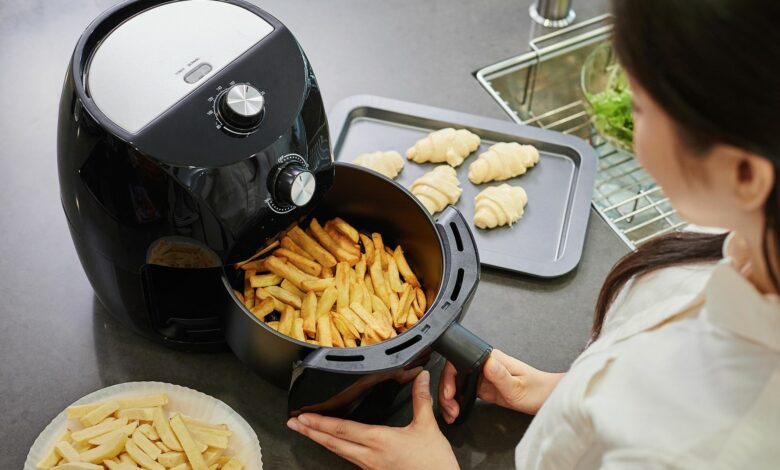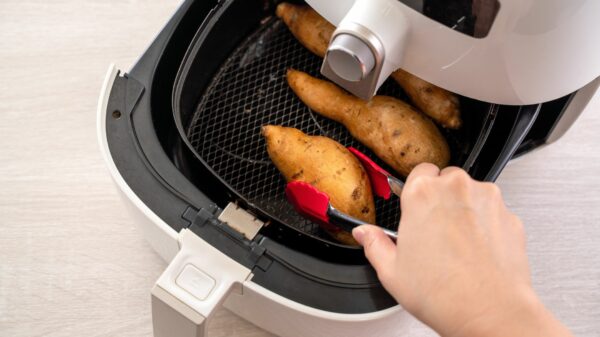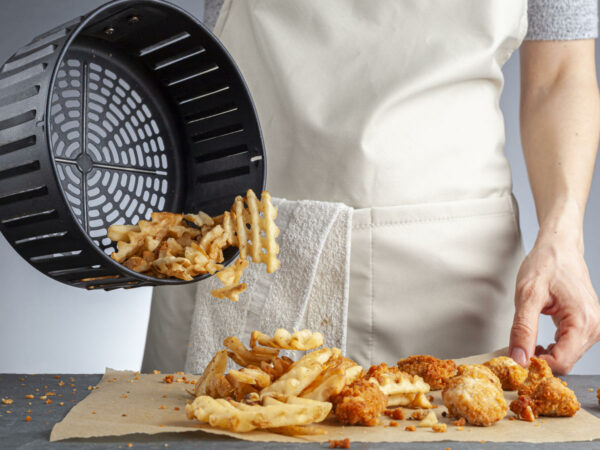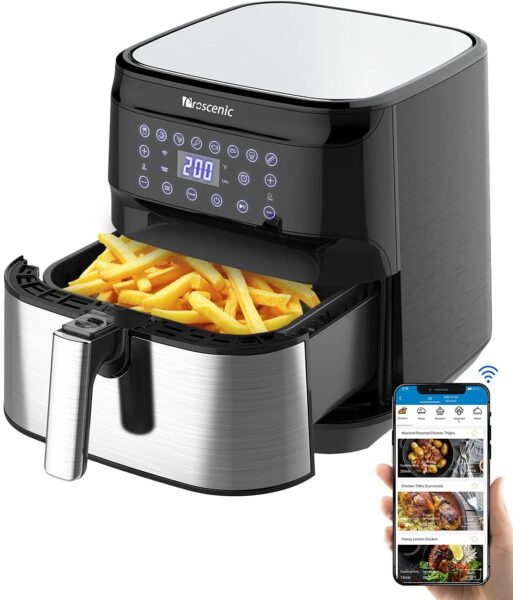How Does Air Frying Work? Check out all the details here!

The air fryer is essentially a more powerful countertop convection oven. The little device, which was developed by Philips, promises to be able to replicate the effects of deep-frying using just hot air and little or no oil.
According to the research firm NPD Group, approximately 40% of homes within the U. S. had one as of July 2020. Everything from prepackaged chicken wings and handmade Irish potato to roasted veggies and fresh-baked cookies will be air-fried.
A heating mechanism and a friend are housed within the upper a part of an air fryer. After you activate the fryer, heated air flows down and round the food in a very fryer-style basket. The food becomes crisp thanks to the short circulation, which is analogous to deep-frying but without the oil.
Air fryers cook food that might rather be submerged in oil by circulating hot air. The An air fryer’s frying chamber distributes heat from a component near the food, and a fan circulates hot air. counting on the model, temperatures can reach 250 °C (482 °F). In an air fryer, there is not plenty of oil utilized. Compared to non-convection ovens, cooking times within the air fryer are often lowered by up to twenty.
By totally submerging meals in heated oil, considerably above the boiling point of water, traditional frying methods cause the Maillard effect at temperatures starting from 140 to 165 °C (284 to 329 °F). The meal is coated in a very thin layer of oil, heated, and the reaction is started using circulating air heated to 200 degrees Celsius (392 degrees Fahrenheit). As a result, the equipment can brown meals like potato chips, poultry, fish, steak, cheeseburgers, fries, or pastries with 70% to 80% less oil than a regular deep fryer.
Temperature and timer adjustments are available on most air fryers, with more authentic cooking. Typically, food is cooked in a very basket on a drip tray. The basket must be agitated regularly, either manually or with the assistance of an integrated food agitator. Convection ovens and air fryers cook food similarly; however, air fryers are typically smaller and produce less heat. Because the more significant amount of oil utilized in traditional frying permeates the foods (or the coating batter, if used) and adds its flavour, the taste and consistency of dishes prepared using conventional fried methods and air fried techniques don’t seem to be identical.
Some air fryers come with additional attachments for specialised types of cooking, such as pizza pans, skewer racks, grilling trays, and cake barrels. Air fryers, like regular convection ovens, may roast, steam, and dry food. Dishes produced by deep-frying have a greater fat content than foods prepared by other techniques. A fried malformation, for example, contains more fat than roasted chicken of the same size. Some brands claim that using an air fryer can help cut fried foods’ fat content by 75%.
This is because air fryers use lots less fat than traditional deep fryers. Many deep-fried recipes raise up to three cups (750 ml) of oil, yet air-fried meals only require about one tablespoon (15 mL).
Deep fryers use to 50 times more oil than air fryers, and while the food doesn’t absorb all of that oil, utilizing an air fryer can dramatically reduce your food’s overall fat level.
When researchers evaluated the properties of deep-fried versus air-fried tater, they found that air-frying produced a product with far less fat but the identical colour and moisture content. this could significantly influence your health, as consuming more fat from vegetable oils has been linked to an increased risk of cardiovascular disease and inflammation.

How to use an air fryer:
1. Fill the basket along with your food.
The basket may accommodate anywhere from 2 to 10 quarts, looking on the dimensions of your air fryer. In most circumstances, 1 or 2 teaspoons of oil are going to be needed to assist the meal get crispy.
2. choose a time and a temperature.
Air fryer cooking times and temperatures range from 5 to 25 minutes at 350° to 400°F, depending on the food you’re cooking.
3. Allow the meal to cook.
To assist the food crisping up evenly, you’ll must flip or turn it halfway through the cooking period. it’s vital to scrub your air fryer once you’ve finished cooking.
To begin with, a disclaimer: air fryers aren’t deep fryers. the amazing thing about air fryers is that they’re filled with hot air. Because ovens utilise air as a heat source, whereas deep-frying uses fat as a heat source, they’re essentially miniature, powerful ovens. Because air fryers are ovens instead of fryers, the onion rings at Cone-n-Shake or the calamari rings at your favourite bar and grill won’t be the identical because the ones you get from your air fryer.
As a result, air fryers are far less oil-intensive and messier than deep-frying. Even better, these tiny ovens are capable of way more than simply making fake fried food. Beautifully browned veggies, crackly-skinned chicken wings, and light-weight and airy cakes are all within grasp with an air fryer.
Different Types of Air Fryers
This article is about air fryers with baskets. The basket-type air fryer, the foremost prevalent variety on the market, resembles a wacky coffee machine with a replaceable basket in its belly. This air fryer has one purpose: air frying.
Boxy multi-function air fryers, like the Beville Smart-Oven, the Cuisinart Air Fryer kitchen appliance, and therefore the June Oven, also are available. These appliances resemble toaster ovens on steroids, and air frying is simply one in every of the features (among slow cooking, dehydrating, and toasting). They also carry more food than air fryers with baskets.
Don’t surrender just yet if you have got a multi-function countertop oven with an air fryer setting. This tutorial still contains some beneficial advice for you.
Bottom of Form
Your air fryer works in the same way as a convection oven. It’s tiny but powerful, and it can roast, broil, or bake. It is not suitable for deep frying. The top rack of a traditional oven is usually the hottest because heat rises, resulting in uneven cooking. (This is also why many cookie recipes instruct you to rotate baking sheets halfway through baking from top to bottom and back to front.)
In a convection oven, on the other hand, fans circulate hot air to keep the temperature consistent throughout the oven. Air fryers differ from convection ovens in that its airflow is meant to mimic the heat distribution of deep-frying more precisely in hot fat. However, for our needs, the convection oven comparison suffices.

What to Expect the First Time
Remove any removable components from the package after it has been opened. This will most likely contain a detachable basket with a grate or perforated tray in the bottom. They should be washed and dried. Place the air fryer at least eight inches away from the wall on a heat-resistant surface. Take out and reinstall the grate and basket.
Note: Some manufactures advocate running the air fryer empty for 10 minutes before using it to allow it to off-gas. There may be a minor chemical odour (one guidebook described it as “new appliance smell”), so turn on the vents or open the windows. It should be a one-time occurrence.
Essential Tips to Keep in Mind
- • Always maintain the grates in the basket. This permits hot air to circulate the dish while also preventing the food from becoming saturated with oil.
- Air fryers make a lot of noise. Whirring fans can be heard when it’s running.
- It’s a hands-on experience. Even browning necessitates removing the basket and rearranging the food every few minutes.
- It’s alright to take a look through the basket. It’s possible to do this at any point during the cooking process. There’s no need to turn off the machine because it turns off when the basket is removed.
- As a result, make sure the drawer is entirely closed, or it will not switch back on. You’ll notice it because the air fryer will go silent.
- Food cooks quickly, faster than you’re accustomed to! It’s one of the air fryer’s best features. The instructions for your air fryer should have a table of cooking times and temperatures for common items. The cook time will be shorter if there is less food in the basket; the cooking time will be longer if there is more food.
- It’s possible that a slightly lower temperature is required. Many air fryer recipes ask for lower temperature settings than traditional fryer recipes. This may appear suspicious but bear with it. Again, because air fryers heat up quickly and circulate hot air, a slightly lower temperature will help keep food from becoming excessively dark or crispy on the exterior while remaining adequately cooked on the inside.
What Size Do You Need?
The problem is that basket-style air fryers can’t hold a lot of food. If you accept this, you and your air fryer will have a lot better relationship.
An air fryer with a capacity of 1.75 to 3 quarts is suitable for cooking meals for one or two people. Also, don’t anticipate any leftovers. Even a big air fryer (four to five quarts) frequently requires batch cooking. You’ll probably need to cook a recipe in more than one batch if it serves more than two people. Consumer Reports discovered that several air fryers’ capacity was somewhat less than what manufacturers advertised. This may sound tedious, but keep in mind that air fryers cook food quickly.
To Preheat or Not to Preheat?
That is the issue.
Unlike your range’s large oven, an air fryer doesn’t need a full half hour to heat up. It should just take a few minutes to preheat. A light on some air fryer models indicates when the machine is preheated.
Preheating is recommended by the manufacturers, although you can skip it entirely if you choose. If you’re using a cold air fryer, your cook time will likely take three or four minutes longer—no big deal! Try both methods and see which one produces the most remarkable results. The recipe could determine it.
Don’t Make These 10 Mistakes:
You won’t melt your face off if you do any of the following activities, but you should attempt to avoid them.
-
Don’t go overboard with the oil.
If you’re going to use that oil, go easy on it! Excess oil collects in the drawer behind the grate, but it may smoke if it builds up too much. In general, if the dish has fat (such as skin-on chicken or frozen fried food), you may not need to oil it at all. On the other hand, vegetables benefit from a small coating of oil since it helps them brown nicely.
-
Cooking spray should not be used to oil the drawer.
That appears to be an excellent idea, right? However, the baskets have a nonstick coating that can be destroyed over time by cooking spray. Instead of using cooking spray, toss your food in oil (which you’re probably already doing) or wipe it clean with an oil-soaked paper towel. I discovered that pre-fried frozen items didn’t require any additional grease.
-
Use only oil with a high smoke point.
Because of its low smoke point, olive oil isn’t ideal for air frying. It will not only smoke at high temperatures, but it will also have an odd aftertaste. The best oils to use are vegetable oil, canola oil, peanut oil, and other high smoke point oils.
-
Make sure the drawer isn’t overflowing.
Air fryers don’t have a large capacity for the space they take up on a countertop. Don’t stuff the drawer with food if you want the most outstanding results (the image used in marketing air fryers is quite misleading). It’s tempting to add another handful of potato sticks or shaved beets, but working in small batches leads in crispier, faster-cooking food.
- Don’t forget to give the basket a good shaking.
Shaking the basket regularly during cooking ensures that the food is evenly heated, resulting in excellent browning. Shake the basket every five minutes, according to many recipes. Breaded fish fillets, for example, should be turned instead. It’s not harmful to forgo shaking or flipping if a recipe calls for it, but it will prevent you from obtaining that profitable, oh-so-similar-to-fried-food finish.
-
Do not simply pour the drawer’s hot contents into a dish.
To remove cooked food, use tongs or a spoon. Excess oil gathers behind the basket’s removable grate, so if you rip it out and put it onto a platter, the oil will flow out along with the grate. This can cause you to get burned, produce a mess, and result in greasy food.
-
Do not put your complete reliance on the timer.
Many basket-style air fryers come with a dial that you may set like an old-fashioned kitchen timer or the kid’s game Perfection. When the timer runs out, it goes PING! The machine then shuts down.
For shorter cooking durations, wind the timer up to 10 or 20 minutes and then back down to the appropriate cooking time on some models.
-
Place the hot drawer away from the counter.
Consider the drawer to be a hot pan. When you remove it from the unit, the bottom will be particularly hot. If heat will damage your countertop, grab the drawer by the handle, not the other parts, and lay it on a trivet or potholder.
When it comes to the air fryer, don’t get all sentimental. Don’t assume the exterior of the air fryer is equally cold. No, parts of it (most likely the back) get hot.

How to Clean Your Air Fryer
Because a build-up of oil might cause the air fryer to smoke, it’s critical to clean it after each usage. In some instances, a paper towel will suffice to clean the drawer and grate. Check your handbook to see whether any parts of your model are dishwasher safe. Hand wash if they’re filthy.
The Best Foods to Cook
Those that cook with dry heat (roasting, baking, and frying) are better for air fryers than foods that cook with moist heat (boiling, braising, and steaming). Experiment with crispy shallots, frozen puff pastry “donuts,” dehydrated tomato slices, perplexingly low-carb bagels, and warmed leftover pizza.
However, we’ve discovered that some foods perform exceptionally well in an air fryer. Please begin with a drum roll:
Frozen meals that have been pre-fried: The air fryer is ideal for classics like chicken tenders, fish sticks, tater tots, and pizza rolls. In general, portion-sized frozen foods or those in bite-size bits cook up quickly in an air fryer and become appealingly crisp.
Recipes made from scratch that resemble pre-fried frozen items include: Think air-fried chicken, mozzarella sticks from an air fryer, crab cakes from an air fryer, and so on.
It’s time to broaden your culinary horizons beyond deep frying! Enjoy using the air fryer for the following:
Cubed winter or summer squash, root vegetables, broccoli or cauliflower florets, and Brussels sprouts are among the veggies that can be roasted or grilled. In the air fryer, they are amazing!
Potatoes: Your air fryer will easily outperform a standard oven when you put a potato (or cut-up potatoes) in it.
Crispy skin-on chicken wings, and it’s faster than roasting them in the oven. Note that this isn’t ideal for parties because air fryers aren’t large enough to accommodate large quantities of wings (unless you’re having a party of people who only eat one hot wing each!).
Cook hot dogs in your air fryer if you prefer franks with a crisp exterior and plump interiors. You’ll never turn around again
Food that has been reheated: Keep in mind that this device resembles a seductive turbo toaster oven. It’s great for reheating meals, and unlike a microwave, it won’t turn once-crispy foods mushy.
Air Frying Vs. Conventional Frying
Unlike traditional deep frying, air frying only requires a few tablespoons of oil to coat the food before cooking, and in many circumstances, no oil is required at all. So, how does a system that uses a fraction of the fat produce the same results as one that uses litres of fat at a time? Let’s look at how traditional frying works to comprehend this better.
Air frying seeks to imitate the traditional deep frying process, which dates back millennia, from when the Chinese employed it to pre-cook meats before roasting in 3000 BC to when Ancient Egyptians cooked dough in oil, as attested by Egyptian wall paintings.
With the introduction of cast iron kettles, edible oil hydrogenation, and advanced methods for freezing, frying, and packing potato products, deep commercial frying became prevalent in the late 1800s and early 1900s. Dehydration is used to achieve the crunchy, golden-brown crust that shatters between your teeth, which distinguishes fried foods from those that are baked, boiled, steamed, and so on.
When food is submerged in 150-200°C hot oil, the oil’s heat diffuses into the uncooked food, gradually cooking it. Meanwhile, the food’s surface temperature meets the oil’s, and moisture on the surface, commonly from a batter layer, soon reaches the boiling point of water and evaporates. This is what causes the fizzing maelstrom of bubbles you see and hear when you first start frying.
When steam bubbles escape from the meal and rise into the oil, they leave behind small fissures and pockets that give the food a porous, crunchy quality while absorbing the surrounding oil.
Proteins denature, caramelize, starches gelatinize, and the Maillard process occurs, browning the food and adding complex, toasted odours while moisture is lost. Deep-frying, unlike shallow frying and stir-frying, allows oil to enter all surfaces of a product simultaneously, resulting in even, efficient cooking and browning.
There’s no denying that air fryers have piqued the interest of health-conscious, time-conscious consumers all around the globe. In cookbooks utilising the air fryer, you’ll find recipes for anything from cheesecake to homemade mini pizzas.
Hundreds of thousands of people watch videos of foodies trying the limits of this strange device on social media platforms like Tik Tok. Air fryers are popular not only because they make crispy fried dishes with less fat and calories but also because they make it simple to create a variety of meals with only one piece of equipment.
They cause less mess and waste than deep frying and can reheat meals without the sogginess that a microwave can generate. While no one knows if this remarkable multipurpose creation is merely a passing craze or if it’s here to stay, we can all appreciate its modern perspective on an age-old culinary technique.
edited and proofread by nikita sharma




